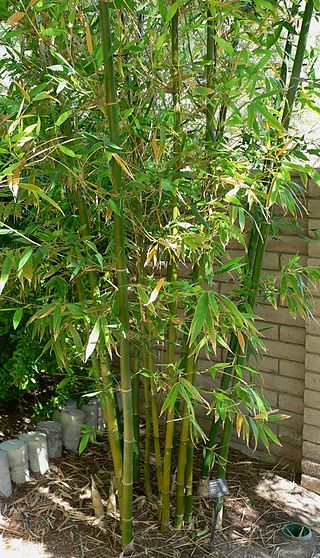
Bambusa is a large genus of clumping bamboos. Most species of Bambusa are rather large, with numerous branches emerging from the nodes, and one or two much larger than the rest. The branches can be as long as 11 m (35 ft).

Cleistanthus is a plant genus of the family Phyllanthaceae, tribe Bridelieae, first described as a genus in 1848. It is widespread in much of the Old World Tropics in Asia, Africa, Australia, and various oceanic islands. Cleistanthus collinus is known for being toxic and may be the agent of homicides or suicides.
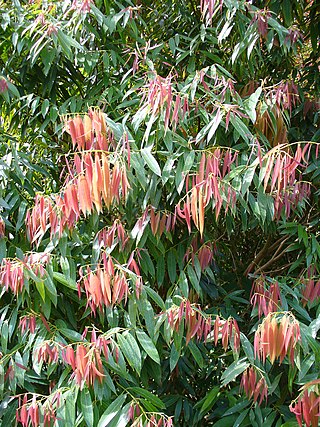
Mesua is a genus of flowering plants in the family Calophyllaceae, native to tropical southern Asia. Common names include ironwood and rose chestnut.

Kayea is a plant genus in the family Calophyllaceae. Its species range from Bangladesh and the eastern Himalayas to Sri Lanka, Indochina, Peninsular Malaysia, Borneo, Sumatra, the Philippines, New Guinea, and Queensland.
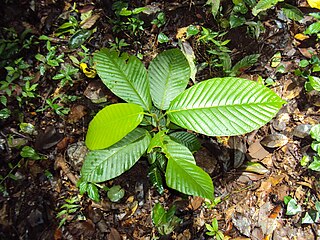
Dipterocarpus is a genus of flowering plants and the type genus of family Dipterocarpaceae.

Phoebe is a genus of evergreen trees and shrubs belonging to the Laurel family, Lauraceae. There are 75 accepted species in the genus, distributed in tropical and subtropical Asia and New Guinea. 35 species occur in China, of which 27 are endemic. The first description of the genus was of the type species P. lanceolata made in 1836 by Christian Gottfried Daniel Nees von Esenbeck in Systema Laurinarum, p. 98.

Actinodaphne is an Asian genus of flowering plants in the laurel family (Lauraceae). It contains approximately 125 species of dioecious evergreen trees and shrubs.
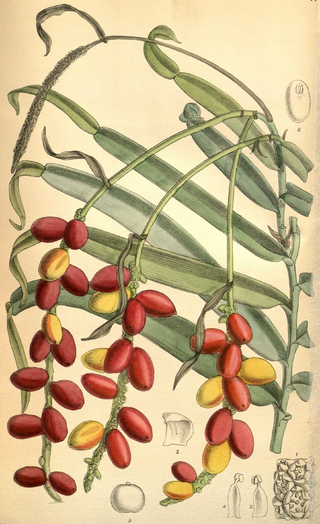
Pothos is a genus of flowering plants in the family Araceae. It is native to China, the Indian Subcontinent, Australia, New Guinea, Southeast Asia, and various islands of the Pacific and Indian Oceans.

Barringtonia is a genus of flowering plants in the family Lecythidaceae first described as a genus with this name in 1775. It is native to Africa, southern Asia, Australia, and various islands of the Pacific and Indian Oceans. The genus name commemorates Daines Barrington.

Alseodaphne is a genus of plants in the family Lauraceae, endemic to China and Southeast Asia. The genus has 96 species of evergreen trees to shrubs. They have bisexual flowers, a fruit stalk that is red, green, or yellow, and black fruit.

Beilschmiedia is a genus of trees and shrubs in family Lauraceae. Most of its species grow in tropical climates, but a few of them are native to temperate regions, and they are widespread in tropical Asia, Africa, Madagascar, Australia, New Zealand, North America, Central America, the Caribbean, and South America. The best-known species to gardeners in temperate areas are B. berteroana and B. miersii because of their frost tolerance. Seeds of B. bancroftii were used as a source of food by Australian Aborigines. Timbers of some species are very valuable.
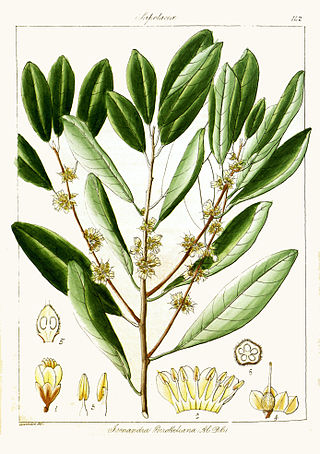
Isonandra is a genus of plants in the family Sapotaceae found in tropical Asia, described as a genus in 1840.
Nothaphoebe is a genus of plant in family Lauraceae. It contains 21 species, which range from mainland Southeast Asia through Indonesia and the Philippines to New Guinea.

Payena is a genus of plants in the family Sapotaceae, described as a genus in 1844. It is native to Southeast Asia.
Prunus arborea is a species of plant in the family Rosaceae. It is found in Indonesia, Malaysia, Singapore, and Thailand.

Benkara is a genus of flowering plants in the family Rubiaceae. It is found in tropical and subtropical Asia from India east to China and the Ryukyu Islands, south to Java and the Philippines. It was described by Michel Adanson in 1763.

Chisocheton is a genus of trees in the family Meliaceae. The genus name comes from the Greek schizos and chiton meaning "split tunic", referring to the lobed staminal tube of C. patens. Their range is from India and tropical China, throughout Malesia and south to New South Wales and Vanuatu.

Diplospora is a genus of flowering plants in the family Rubiaceae. The genus is found in tropical and subtropical Asia.
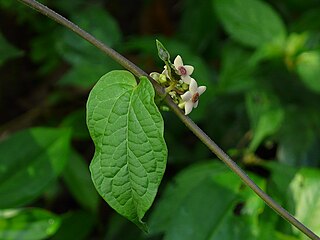
Heterostemma is a genus of plants in the family Apocynaceae, first described in 1834. It is native to India, China, Taiwan, Southeast Asia, Australia, and certain islands in the Pacific.
















